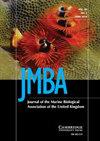New data on South American fur seals and sea lions' occupation of the Wildlife Refuge of Ilha dos Lobos, southern Brazil
IF 0.9
4区 生物学
Q3 MARINE & FRESHWATER BIOLOGY
Journal of the Marine Biological Association of the United Kingdom
Pub Date : 2023-07-28
DOI:10.1017/S0025315423000425
引用次数: 1
Abstract
Abstract We present the most recent data on the seasonal and spatial occupation of South American sea lions (Otaria flavescens) and fur seals (Arctocephalus australis) in the Wildlife Refuge of Ilha dos Lobos (WRIL) in southern Brazil throughout the year, based on aerial photographic counts. Thirty-one aerial photographic counts were conducted between July 2019 and November 2020 to assess monthly differences in the abundance of pinnipeds in the WRIL. The results were analysed using a generalized linear model. Spatial analysis was performed using kernel density. Subadult males of South American sea lion were the most abundant pinniped in the WRIL, followed by juveniles of South American fur seal. A juvenile of Southern elephant seal (Mirounga leonina) was also recorded. South American fur seals showed a marked seasonality, occurring only between July and October, while South American sea lions occurred year-round. Among the months analysed, September exhibited the highest mean abundance (mean 113.75; SD: ± 8.58), followed by August (mean 103.00; SD: ± 15.69). The pinnipeds were more often concentrated in the northern and central parts of the island. This study reinforces the importance of the WRIL as a haulout site for pinnipeds. Considering the seasonal occupation of the island by South American pinnipeds, monitoring is recommended prior to the development of activities in the area.关于南美洲海豹和海狮占领巴西南部Lobos岛野生动物保护区的新数据
摘要:本文基于航空摄影数据,介绍了巴西南部Ilha dos Lobos野生动物保护区(WRIL)南美洲海狮(Otaria flavescens)和海豹(Arctocephalus australis)全年的季节和空间分布情况。2019年7月至2020年11月期间进行了31次航空摄影计数,以评估wwrl中鳍足类动物丰度的月度差异。结果用广义线性模型进行了分析。利用核密度进行空间分析。其中,南美海狮的亚成年雄性鳍状肢数量最多,其次是南美海海豹的幼崽。南象海豹(miounga leonina)幼崽也有记录。南美海狗的活动具有明显的季节性,只在7月到10月之间发生,而南美海狮全年都有活动。在分析月份中,9月平均丰度最高,平均113.75;SD:±8.58),其次是8月(平均103.00;Sd:±15.69)。鳍足类动物更多地集中在岛屿的北部和中部。这项研究强化了WRIL作为鳍足类拖出位点的重要性。考虑到南美洲鳍足类动物对该岛的季节性占领,建议在该地区开展活动之前进行监测。
本文章由计算机程序翻译,如有差异,请以英文原文为准。
求助全文
约1分钟内获得全文
求助全文
来源期刊
CiteScore
2.30
自引率
8.30%
发文量
68
审稿时长
3-8 weeks
期刊介绍:
JMBA is an international journal, publishing original research on all aspects of marine biology. It includes pioneering work taking place today on major issues concerning marine organisms and their environment. Subjects covered include: ecological surveys and population studies of marine communities; physiology and experimental biology; taxonomy, morphology and life history of marine animals and plants; and chemical and physical oceanographic work. Included with 2010 online subscriptions: Marine Biodiversity Records.

 求助内容:
求助内容: 应助结果提醒方式:
应助结果提醒方式:


